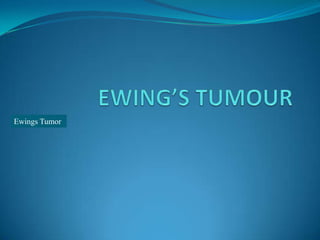
Ewing's sarcoma
- 1. Ewings Tumor
- 2. History: 1928 James Ewing described a rare lesion Diaphysis of long bones Childhood Febrile attacks,anorexia, weight loss & anaemia Rapidly involving other parts of skeleton Radiosensitive Histologically –endothelial elements in marrow
- 3. Willis – All these tumors were not Ewing’s but Neuroblastomas Reticulum cell sarcomas Metastatic tumors
- 4. Ewing’s Sarcoma Epidemiology: 4th. m.c. primary malignancy of bone 2nd. m.c. in age < 30 yrs. Incidence < 1/ million / year 9% of primary malignancies of bone in the Mayo Clinic series.
- 5. Age – Wide age range from infants to elderly m.c. 5 – 15 yrs. Male slightly more than females. Very rare in Africans
- 6. Location: M.c. in metaphysis of long bones ( often extending into diaphysis), Flat bones of shoulder and pelvis. Rarely in spine or small hand & foot bones. Long bones Tibia > fibula > humerus > femur.
- 7. Spread – Whole of the skeleton. Regional lymph nodes.
- 8. Clinical features: Pain – Universal complaint Insidious in onset, long standing, intermittent attacks, responding to analgesics. Often H/O preceding trauma. Slow growing tumor in relation to the shaft of long bones.
- 9. Delay in diagnosis Av. 34 weeks Patient delay – 15 weeks Physician delay 19 weeks – Importance of Xrays & rpt. X rays to compare. During attacks of pain tumor size may enlarge visibly.
- 10. Other clinical features: Fever, erythema & swelling ~ Osteomyelitis Skin – not involved unless surgical exploration done. Pathological # seldom. Later stage – multiple deposits in skull, ribs, sternum, pelvis & other long bones – cachexia & sec. Anaemia.
- 11. Vertebral involvement – severe root pain or paralysis Death – Metastatic involvement of lungs.
- 12. Radiological appearance: X-rays: Classically Destructive lesions, diaphysis long bones, onion peel appearance. Reality Metaphysis long bones frequently extending into diaphysis.
- 13. Diffuse rarefaction towards center of shaft extending to considerable area peripherally. Flat bones: Non-specific destructive lesions & large adjacent soft tissue mass.
- 15. Early stage: Condensation Later Reactive irritation – Onion skin layers Last stage Gross tumor formation, destruction of bone, pathological #s.
- 16.
- 17.
- 18. MRI: Taken of entire bone involved Extent of diseased bone Soft tissue involvement
- 19. Other Investigations: Blood Ix: WBC Leukocytosis, ESR CRP LDH ~ suggestive of infective cause. FNAC – resembles Pus.
- 20. Base line X ray & CT chest – m.c. site of metastasis Bone Scan Bone marrow aspiration – routine R/O diffuse systemic disease USG abdomen liver & spleen.
- 21. Pathology: Begins in - Marrow (Mid shaft) Gross – Color - Greyish-white Areas of necrosis & hemorrhage with cyst formation. Lamellae destruction.
- 22. Medulla Haversian canals Surface. Sub periosteal compensatory layers of new bone are deposited only to be destroyed Onion Skin appearance.
- 23. Histology: Microscopic features – non specific. Intensely cellular Cells – Usually one type Blue, Small, round & polyhedral Arrangement – solid cords or sheets.
- 24. Intercellular substance – minimal Necrosis Remaining cells arrange around the central blood vessel – perithelioma. Nuclei – prominent Mitosis - frequent
- 25. Rossette arrangement with central fibril (Neuroblastoma) Pseudorosette (without fibril) more common. Despite bone destruction Giant cells/ osteoclasts are not found Nor new bone Except sub periosteal deposits.
- 26. Vessels & lymphatics Tumor emboli tumor spread.
- 27. Cytogenetics & Immunohistochemistry: To differentiate from other small blue cell tumors. m.c. translocations in >90% cases t(11;22)(q24;q12) diagnostic of Ewing’s. Other diagnostic translocations include t(21;22)(q22;q12) & t(7;22)(p22;p12)
- 28. IHC Staining for MIC2 gene products – Specific PAS + usually (high intracellular glycogen). Reticulin – ( c.f. lymphomas)
- 29. Histological D/D Lymphomas – PAS -, Reticulin +, Embryonal rhabdomyosarcoma – desmin , myoglobin, muscle specific actins + Hemangeopericytomas – Factor VIII + Small cell metastatic carcinomas & Melanomas – Cytokeratin +
- 30. Other D/D: Chronic Osteomyelitis Metastatic Neuroblastoma Histiocytosis Rarely Osteolytic Osteosarcoma
- 31. Treatment: Adjunct or Neoadjunct Chemotherapy or both – for distant metastasis. Local Treatment: (Controversial) Highly radiosensitive Wide resection Decreases local recurrence to <10% Increases overall survival
- 32. Large, central, unresectable – Radiation Small, more accessible lesions – Surgery Choice is individual based. Repeat Staging studies after neoadjunct chemotherapy. Repeat X rays - ossification Repeat MRI - soft tissue mass.
- 33. At this stage – If Lesions can be resected with wide margins & an acceptable functional deficit – SURGERY. If not – RADIATION. Radiation: Marginal Resection or Contaminated wide resection.
- 34. Treatment Plan: After long D/W patients & parents Include expected function after amputation, limb salvage & radiation Inherent short & long term risks with each option. Disease relapse – and its prognosis.
- 35. Survival rates : Long term survival rates reported from most studies – 60-70% Before the use of chemotherapy – 10 %
- 36. Prognostic factors: Location & Size of primary lesion. Older age of presentation & male gender. Distant metastasis – worst prognostic factor with 20% long term survival even with aggressive therapy and surgery. Disease relapse Time to relapse
- 37. Histological grade is of no significance as ALL EWING’S SARCOMAS ARE CONSIDERED TO BE HIGH GRADE. Fever, anemia, WBC, ESR, LDH indicate extensive disease so worse prognosis. Aberrant p53 expression & histological response to chemotherapy.
